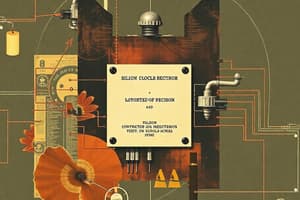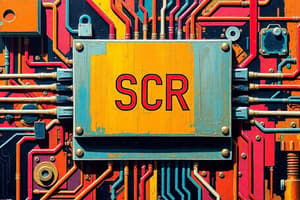Podcast
Questions and Answers
What does SCS stand for?
What does SCS stand for?
Silicon-Controlled Switch
The anode gate in an SCS can be used to turn the device on or off.
The anode gate in an SCS can be used to turn the device on or off.
True (A)
What is the primary advantage of the SCS over the SCR?
What is the primary advantage of the SCS over the SCR?
- Higher power ratings.
- More complex control circuit.
- Lower cost and simpler design.
- Faster turn-off time. (correct)
What is the typical range for maximum anode currents in SCS devices?
What is the typical range for maximum anode currents in SCS devices?
The ______ is a mechanism used to turn off an SCS by providing a positive pulse to the anode gate.
The ______ is a mechanism used to turn off an SCS by providing a positive pulse to the anode gate.
Which of these is NOT a common application of the SCS?
Which of these is NOT a common application of the SCS?
In a simple alarm circuit using an SCS, what triggers the alarm?
In a simple alarm circuit using an SCS, what triggers the alarm?
The rate effect is a phenomenon that can accidentally trigger an SCS due to stray capacitance.
The rate effect is a phenomenon that can accidentally trigger an SCS due to stray capacitance.
What is the primary advantage of the GTO over the SCR or SCS?
What is the primary advantage of the GTO over the SCR or SCS?
The turn-off time of a GTO is typically much slower than the turn-off time of an SCR.
The turn-off time of a GTO is typically much slower than the turn-off time of an SCR.
What is a common application of the GTO?
What is a common application of the GTO?
LASCRs are a type of SCR that are triggered by light instead of an electrical gate pulse.
LASCRs are a type of SCR that are triggered by light instead of an electrical gate pulse.
What is a common application of LASCRs?
What is a common application of LASCRs?
In a light-switching circuit using LASCRs, the supply voltage will appear across the ______ when light falls on at least one LASCR.
In a light-switching circuit using LASCRs, the supply voltage will appear across the ______ when light falls on at least one LASCR.
A latching relay using an LASCR offers complete isolation between the input and output circuits.
A latching relay using an LASCR offers complete isolation between the input and output circuits.
What is the main difference between a Shockley diode and an SCR?
What is the main difference between a Shockley diode and an SCR?
The Shockley diode can be used as a ______ for an SCR.
The Shockley diode can be used as a ______ for an SCR.
The Shockley diode has a similar characteristic curve to the SCR but with no gate current.
The Shockley diode has a similar characteristic curve to the SCR but with no gate current.
What is a diac?
What is a diac?
The diac has a breakover voltage in both positive and negative directions.
The diac has a breakover voltage in both positive and negative directions.
What are the two terminals of a diac called?
What are the two terminals of a diac called?
The ______ is fundamentally a diac with an added gate terminal.
The ______ is fundamentally a diac with an added gate terminal.
What is the primary function of the gate terminal in a triac?
What is the primary function of the gate terminal in a triac?
The characteristics of the triac in the first and third quadrants are identical to the diac characteristics.
The characteristics of the triac in the first and third quadrants are identical to the diac characteristics.
Flashcards
Silicon-Controlled Switch (SCS)
Silicon-Controlled Switch (SCS)
A four-layer pnpn device with an additional anode gate terminal. It can be turned on or off by applying a negative or positive pulse to the anode gate, respectively. It has faster turn-off time compared to SCRs.
Gate Turn-off Switch (GTO)
Gate Turn-off Switch (GTO)
Similar to the SCR, it has only three terminals but can be turned on and off by applying a pulse to the cathode gate. It offers faster switching speeds compared to SCRs and improved control.
Light Activated SCR (LASCR)
Light Activated SCR (LASCR)
A type of SCR that relies on light energy to trigger it into the conducting state. It has a sensitive silicon layer that responds to light, offering light sensing capabilities.
Shockley Diode
Shockley Diode
Signup and view all the flashcards
Diac
Diac
Signup and view all the flashcards
Triac
Triac
Signup and view all the flashcards
Holding Current
Holding Current
Signup and view all the flashcards
Breakover Voltage (Vʙʀ)
Breakover Voltage (Vʙʀ)
Signup and view all the flashcards
Turn-on Time
Turn-on Time
Signup and view all the flashcards
Turn-off Time
Turn-off Time
Signup and view all the flashcards
SCS Voltage Sensor
SCS Voltage Sensor
Signup and view all the flashcards
SCS Alarm Circuit
SCS Alarm Circuit
Signup and view all the flashcards
Simple Sawtooth Generator
Simple Sawtooth Generator
Signup and view all the flashcards
GTO Current Control Circuit
GTO Current Control Circuit
Signup and view all the flashcards
Light Switching Circuits
Light Switching Circuits
Signup and view all the flashcards
LASCR Latching Relay
LASCR Latching Relay
Signup and view all the flashcards
Shockley Diode as SCR Trigger
Shockley Diode as SCR Trigger
Signup and view all the flashcards
Triac AC Power Control Circuit
Triac AC Power Control Circuit
Signup and view all the flashcards
Transistor Equivalent Circuit
Transistor Equivalent Circuit
Signup and view all the flashcards
pnpn Device Characteristics
pnpn Device Characteristics
Signup and view all the flashcards
Regenerative Action
Regenerative Action
Signup and view all the flashcards
Triggering/Turning On
Triggering/Turning On
Signup and view all the flashcards
Turning Off
Turning Off
Signup and view all the flashcards
Short-Circuit Representation
Short-Circuit Representation
Signup and view all the flashcards
Open-Circuit Representation
Open-Circuit Representation
Signup and view all the flashcards
Study Notes
Electronics (2) - Lecture 9: Thyristors
-
Course Code: EEG 215
-
Lecturer: Dr. Ayad Shohdy
-
Department: EE Dept., Sohag University
-
Date: Wednesday, December 6, 2023
-
Four-layer Devices
- SCR (silicon-controlled rectifier)
- SCS (silicon-controlled switch)
- GTO (gate turn-off switch)
- LASCR (light-activated SCR)
- Shockley diode
- Diac
- Triac
Silicon-Controlled Switch (SCS)
- Four-layer pnpn device
- An anode gate is added
- Graphic symbol and transistor equivalent circuit shown
- Characteristics are similar to SCR
- Anode gate current affects required anode-to-cathode voltage
- Negative pulse at anode gate turns on device
- Positive pulse turns device off (regenerative action)
- Turn-on gate current is larger than cathode gate current
SCS Turned Off
- Three fundamental turn-off circuit types
- Positive pulse at anode gate turns off SCS
- Transformer pulse on transistor, changes impedance for current to turn off SCS
- Pulse applied to cathode gate turns off SCS with correct resistor value (RA)
GTO (Gate Turn-Off Switch)
- Third pnpn device with three external terminals
- Transistor equivalent and characteristics similar to SCR and SCS
- Turn-on time is similar to SCR (typically 1 µs); turn-off time is much faster than typical SCR (5–30 µs)
- Maximum rms current and dissipation ratings limited to 3 A and 20 W respectively
- Higher gate current needed to turn off (20 mA for GTO vs. 30 µA for SCR)
LASCR (Light Activated SCR)
- SCR whose state is controlled by light falling on a silicon semiconductor layer.
- Gate lead is also available for triggering using typical SCR methods
- Maximum current rating is 3 A; power rating is 0.1 W
- Junction temperature increases, light required to activate the device decreases
- Applications in light controls, relays, phase control and motor control
Shockley Diode
- Four-layer pnpn diode with two terminals
- Characteristics are same as SCR (IG = 0)
- "Off" state until breakover voltage (VBR) is reached.
- Avalanche conditions then develop and device turns on
- Commonly used as a trigger switch for SCRs
Diac
- Two-terminal parallel inverse combination of semiconductor layers
- Allows triggering in either direction
- Breakover voltage in either direction
- No cathode terminal; has anode 1 and anode 2
- Breakdown voltages close in magnitude for each device
Triac
- Diac with gate terminal for controlling turn-on in either direction
- Characteristics in first and third quadrants are somewhat different from a diac
- Can control AC power to a load using positive and negative portions of input sinusoidal signal
- Varying resistor controls conduction angle
- Can handle up to 10 kW or more loads
Studying That Suits You
Use AI to generate personalized quizzes and flashcards to suit your learning preferences.




